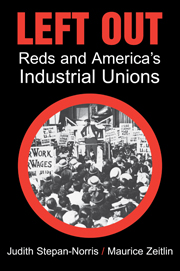Book contents
- Frontmatter
- Contents
- List of Figures and Tables
- Prefatory Note
- Acknowledgments
- Abbreviations
- 1 The Congress of Industrial Organizations: Left, Right, and Center
- 2 “Who Gets the Bird?”
- 3 Insurgency, Radicalism, and Democracy
- 4 Lived Democracy: UAW Ford Local 600
- 5 “Red Company Unions”?
- 6 Rank-and-File Democracy and the “Class Struggle in Production”
- 7 “Pin Money” and “Pink Slips”
- 8 The “Big 3” and Interracial Solidarity
- 9 The Red and the Black
- 10 Conclusion: An American Tragedy
- 11 Epilogue: The “Third Labor Federation” That Never Was
- References
- Author Index
- Subject Index
1 - The Congress of Industrial Organizations: Left, Right, and Center
Published online by Cambridge University Press: 28 July 2009
- Frontmatter
- Contents
- List of Figures and Tables
- Prefatory Note
- Acknowledgments
- Abbreviations
- 1 The Congress of Industrial Organizations: Left, Right, and Center
- 2 “Who Gets the Bird?”
- 3 Insurgency, Radicalism, and Democracy
- 4 Lived Democracy: UAW Ford Local 600
- 5 “Red Company Unions”?
- 6 Rank-and-File Democracy and the “Class Struggle in Production”
- 7 “Pin Money” and “Pink Slips”
- 8 The “Big 3” and Interracial Solidarity
- 9 The Red and the Black
- 10 Conclusion: An American Tragedy
- 11 Epilogue: The “Third Labor Federation” That Never Was
- References
- Author Index
- Subject Index
Summary
Communism is now only a memory, but its specter still haunts America, obscuring and distorting our nation's recent past. The time has come to rid ourselves of its dead hand, and to try, in E. H. Carr's phrase, “to master and understand [the past] as the key to the understanding of the present.” We aim, therefore, to dispel certain coercive illusions about the long “Red Decade,” from the early 1930s through the late 1940s, when American capitalism was challenged by a “powerful and pervasive radical movement,” built and led by Communists. “It is unfortunate, though very natural” – if we may borrow Thomas Carlyle's fitting comment on the French Revolution – “that the history of this period has so generally been written in hysterics. Exaggeration abounds, execration, wailing; and, on the whole, darkness … so that the true shape of many things is lost for us.”
We have tried in this work, though a series of interrelated systematic empirical analyses, to illuminate the “darkness” that still envelops the reality of Communist-led industrial unionism in America. For, despite the supine and craven obedience of the Communist Party's (CP) officials and functionaries to the dictates of the Soviet regime through every tortuous twist in its line, Communist unionism during the Congress of Industrial Organizations (CIO) era was “the main expression of native, working class radicalism in the United States.”
- Type
- Chapter
- Information
- Left OutReds and America's Industrial Unions, pp. 1 - 23Publisher: Cambridge University PressPrint publication year: 2002



